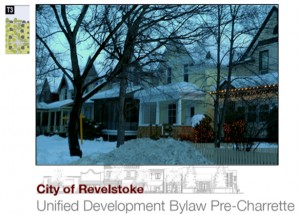How do you envision the future? Should Revelstoke be a more walkable, people friendly community dominated by unique neighbourhoods? Or should we stick with the status quo?
About 80 people gathered at the Community Centre on Thursday evening to consider those questions as the City Planning Department held what it was calling a “Pre-Charette Workshop” ( a charette is any collaborative session in which a group drafts a solution to a design problem) on the proposed Unified Development Bylaw. The UDB will, if it passes, provide the City with a framework and guidelines for more environmentally-friendly and socially progressive development.
City Planner John Guenther regards the workshop as a major success because, for the first time, it brought together the various community groups formed last autumn to provide input to the planning department regarding development.
“We have been building towards this for three or four months with the community groups,” he said in an interview. “Their performance really caps what they’ve done so far.”
Members of the groups, along with interested members of the public, heard presentations from Guenther and Hazel Borys of the Winnipeg-based consultancy Placemakers (www.placemakers.com) as they talked about a greener, more people-friendly future for Revelstoke that places “an emphasis on walkable neighbourhoods.”
“What we really need you to do is extract the DNA of this place,” Borys told the audience last week.
She noted that a lot of good work towards that goal has already been through the Official Community Plan process. But while the OCP is an important set of guidelines, it does not have the force that a bylaw can bring to bear on issues arising out of continued development. In terms of development, there are basically two frameworks. The traditional framework is North America separates different residential, recreational, commercial and industrial development and forces communities to plan for the heavy vehicular traffic that results from that.
The unified development model emphasized environmental, social and economic goals that promote more walkable and cycle-friendly mixed-use neighbourhoods. It will be governed by a set of design principles that strive to ensure communities are: compact; diverse; mixed-use; adaptable; focused on context-based design; pedestrian-friendly; transit supportive; cognizant of their sense of place; capable of integrating natural systems; and that they strengthen and direct new development towards existing neighbourhoods.
Many Revelstokians may rightly say that this city is already pretty people-friendly. However, there has been a noticeable increase in vehicular traffic here. And this community is not so small that it will escape gridlock at some future point if it remains a car-oriented city. There are resort communities in Eastern Canada today that, even though they have populations of less than 1,000 permanent residents, have ludicrously high levels of vehicular traffic.
Borys says there is much more movement towards greener, more human-oriented communities in Western Canada than the East and the Unified Development Bylaw now being discussed proposes we look at our city as a series of so-called “transect zones” that describe the way certain areas of the community should develop (click here — https://legacy.revelstokecurrent.com//wp-content/uploads/2010/02/online-Transect-Zones.pdf — to see a PDF of the City’s transect zones). These transect zones are: T1, untamed wilderness; T2, rural properties; T3, general neighbourhoods that allow home occupations and ancillary dwellings such as carriage houses and secondary suites but usually have no retail; T4, general urban neighbourhoods that are still essentially residential but which permit a variety of building types from single-family homes to apartments, condos, infill and some retail outlets in the form of corner stores; T5, this is the urban centre, which wile downtown is developed in a manner that favours people over vehicles. If the Unified Development Bylaw is approved these transect zones will not replace the current set of zones (R1, R2, etc) that now exist.
Instead they will act as a kind of overlay that will give developers the option of following those guides or the old zones. Developers who declare that they will follow the transect zones will thereby avoid a public hearing on their plans.
Of course, that leads one to ask certain kinds of questions…
Please turn to Are you dreaming of a greener Revelstoke? Part 2 at https://legacy.revelstokecurrent.com//2010/02/02/are-you-dreaming-of-a-greener-revelstoke-part-2.




